Leapfrogging to BS-VI suits India best, says ICCT
The US-based International Council on Clean Transportation is a votary for the shift to BS VI, saying that the health benefits far outweigh costs in vehicles and tech.
On January 6, 2016, Nitin Gadkari, Union Minister of Road Transport, Highways & Shipping, had announced via his official Twitter account – “Me and my colleagues Prakash Javadekar (Union Minister of State for Environment, Forest & Climate Change), Anant Geete (Union Minister of Heavy Industries & Public Enterprises) and Dharmendra Pradhan (Union Minister of State for Petroleum & Natural Gas) have taken a unanimous decision to leapfrog to BS-VI directly from 01/04/2020”
Pradhan too tweeted that “commitment to meet the deadline of 01.04.2020 for introduction of BS-VI fuel in country reaffirmed – great decision.”
Pradhan’s tweet, which particularly hails the government’s firm decision of skipping BS-V emission norms and leapfrogging to BS-VI, erases all doubts about the oil marketing companies’ (OMCs) disagreement over being able to deliver the required fuel grade in four years’ time.
The government’s decision on implementing BS-VI emission norms on new vehicles with effect from April 2020 has drawn concerns from the automotive industry specifically in the areas including rising costs, engine bay design issues, using diesel particulate filters (DPF) vs fuel efficiency trade-off, design time for tailor-made solutions for vehicles sold in India. OEMs and key suppliers of emission-related technologies have expressed their reservations against the early deadline.
THE WRITING WAS ON THE WALL
It can be recalled that while addressing the automotive industry at the 55th SIAM annual convention in New Delhi last year, Gadkari had urged the fraternity to work upon stricter vehicular emission related technologies.
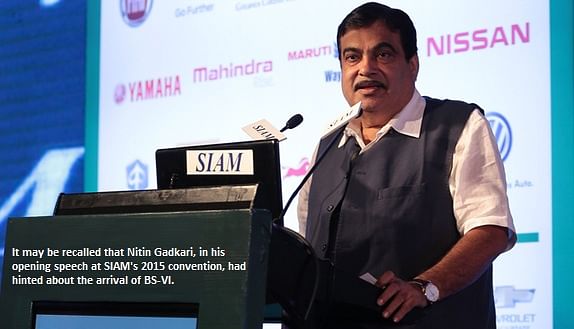
“We cannot continue to postpone our decision of delaying the implementation of stricter emission norms (and of pan-India execution of one country – one fuel policy – highlighting the delay in pan-India availability of BS IV-fuel, and the opposition for early deadline by the auto industry). Soon someday the Supreme Court will pass a decision of implementing stricter norms and we will have no choice but to adhere to the same,” Gadkari had said addressing the large gathering of representatives from the automotive industry on September 2, 2015.
Reports suggest that the unanimous decision from the Union Ministers came just a day after the Supreme Court had finally asked for implementing cleaner vehicular emission norms. It is essential to note that the apex court had asked the government for implementing the BS VI emission norms earlier than April 1, 2021.
While this has come at the forefront of the previous deadline (set by the last central government) of implementing BS-VI emission norms from April 1, 2024, it is known that the expert committee report under Saumitra Chaudhuri had, after reviewing the inputs from the Ministry of Petroleum & Natural Gas (MP&NG), Ministry of Road Transport & Highways (MoRTH), Ministry of Environment & Forests (MoEF), Central Pollution Control Board (CPCB), and the Department of Heavy Industries, had recommended the implementation of BS VI emission norms by 2020.
RECOMMENDATIONS BY AN EXPERT COMMITTEE
A document titled ‘Fifth report - Standing Committee on Petroleum & Natural Gas (2014-15) – 16th Lok Sabha – Ministry of Petroleum & Natural Gas – National Auto Fuel Policy”, which was presented to Lok Sabha on May 7, 2015 (and was also laid in the Rajya Sabha on the same date) quotes “MP&NG has taken a decision to implement BS-IV fuel as per the roadmap given in the report (by 1st April 2017 in the entire country) and to go from BS-IV to BS-VI directly (by 1st April 2019 to 2020)”.
“The Committee have been informed (by the MP&NG) that there is no change between BS-V and BS-VI fuel quality as both envisage sulphur content at less than 10ppm.”
It further quotes that “the Expert Committee in its report on Auto Fuel Vision and Policy, 2025 has projected an amount of Rs 80,000 crore for upgrading the fuel quality to BS-IV (from BS-III) and then to BS-V. OMCs have sought government support to mobilise the funds.
In this context, it is stated that the Ministry is considering a proposal to switch over directly to BS-VI auto fuel from BS-IV instead of step-wise switching from BS-IV to BS-V and then BS-V to BS-VI. Accordingly, the Ministry has asked OMCs to project their fund requirement to upgrade the fuel quality as per above”.
The recommendation number three in the said document conveys that “The Required infrastructure for production of BS-IV and BS-V/VI fuels are being developed in oil refineries, the Committee recommends the Ministry to strictly adhere to the implementation schedule of BS-IV quality of fuel for the entire country by April 2017 and further BS-VI by 2020 so that ‘One Country - One Fuel Norm’ will become a reality.”
It is clear (and logical) that the MP&NG has decided in favour of asking all OMCs to upgrade their respective refineries in a single leap addressing the fuel requirements and achieving the operational stability in the long run.
REDUCING SULPHUR CONTENT IN FUELS
Throwing light on the intricacies of fuel grades required for BS-IV, V and VI standards, Dr Anurag A Gupta, ex-general manager, R&D, Indian Oil Corporation, told Autocar Professional that “the fuel grades required for BS-IV and BS-V vary with respect to the quantity of pollutants in the fuel. For achieving BS-IV fuel quality, the sulphur content has to be brought down from 150ppm to 50ppm in petrol and from 350ppm to 50ppm in diesel. In BS-V or BS-VI grade fuel, the sulphur content comes down to less than 10ppm, which is already achieved. The BS-V and VI norms lie in fuel neutral scenario as there is no change required.”
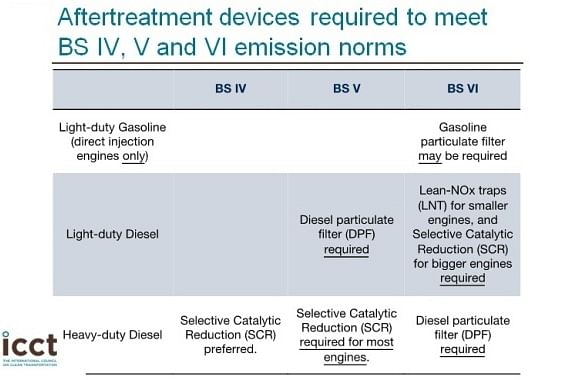
“To achieve reduced sulphur content, new process units for sulphur reduction, hydrogen generation and sulphur recovery units are to be installed at the refineries. Bigger chunk of investment is, however, required in setting up pan-India BS-IV grade fuel supply. If the government finances the upgrade, the time lag can be easily reduced by two years. The lead time will also be consumed in cleaning the sulphur deposits from the pipelines and tankers,” added Gupta, who estimates that the task is not unmanageable.
However, he also underlined that refineries situated in the eastern part of the country are not ready and need more attention.
WHAT ICCT THINKS
The International Council on Clean Transportation (ICCT), a US-based independent, non-profit organisation involved in technical and scientific analysis of vehicular emissions worldwide, supports the implementation of the BS-VI emission norms in India by 2020.
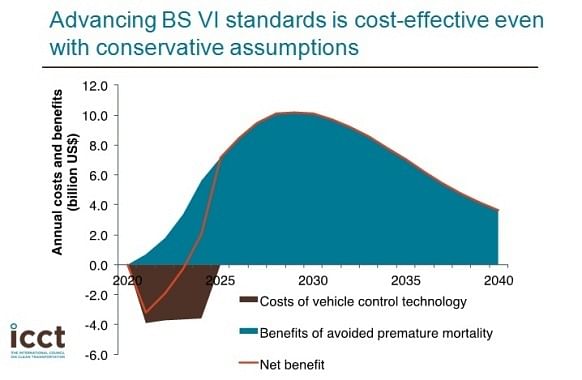
In his exclusive communication with Autocar Professional, Anup Bandivadekar, passenger vehicles program director at ICCT, says: “The move to skip BS-V, and go directly to BS-VI makes a lot of sense from a technical point of view. Advancing the date of implementation of BS-VI will generate tremendous health benefits over the long term, and the additional costs of cleaner fuel and vehicles will be offset by resulting health benefits (for the economy as a whole) in a matter of a few years. So, on the whole, this is a very positive development. This advancement will also have cost implications for the vehicles. While the costs will be moderate for petrol cars, diesel cars are likely to get more expensive by about Rs 50,000 to Rs 80,000 per vehicle depending on engine size.”
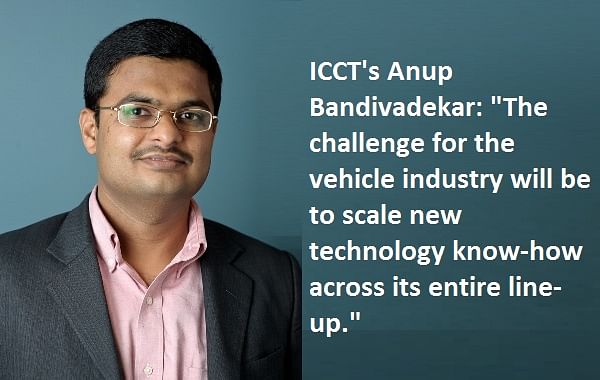
Expressing his views on the challenge for the auto industry, he says, “The challenge for the vehicle industry is to scale this technology know-how across its entire line-up. As a result, it will have to invest significantly in integration of diesel after-treatment technology with improved engines and on-board diagnostics (OBD). This requires major engineering efforts, but is not a showstopper.”
Indian automakers such as Tata Motors and Mahindra & Mahindra are known to already have the access to the BS-VI technology that goes into cars and CVs. For example, M&M’s SsangYong has been selling Euro-6 vehicles in EU and Korea for the last few years. M&M is also known for exporting the XUV5OO and other models fitted with DPFs in Europe.
“A similar case can be made for Tata Motors, which has been selling Euro 6 trucks (Prima/Novus) under the Tata Daewoo brand in Korea since last year. They (OEMs) will have to work with emissions control suppliers, most of whom are global players, to customise the solution for the Indian market, but there is plenty of time to do that between now and 2020,” he writes.
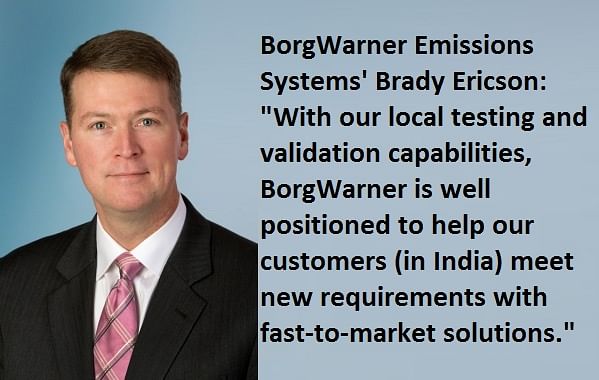
Supporting the government’s move, Brady Ericson, president and general manager of BorgWarner Emissions Systems, which currently supplies exhaust gas recirculation technologies to leading OEMs in India including Maruti Suzuki India, said: “BorgWarner fully supports implementing BS-VI emission standards in India by 2020. The country is facing significant air quality challenges. If fuel can meet the required quality levels across India, automotive technologies are already available to meet the accelerated timeline. BorgWarner’s technologies are specifically engineered to help automakers improve fuel economy, emissions and performance. With our local testing and validation capabilities, BorgWarner is well positioned to help our customers meet new requirements with fast-to-market solutions.”
Addressing the concerns about accommodating the DPF beneath the bonnet with an all-new engine bay design for small cars, Bandivadekar, who is based in San Franscisco (California), underlines that “packaging is always a challenge for small cars. That said, there are small cars that meet Euro 6 and are less than 4 metres long — the VW Polo is a good example. In the long run, the ICCT suggests that the taxation of vehicles in India should be based on CO2 emissions as opposed to engine size and vehicle length.”
However, he also cautioned that “The draft notification of BS-VI standards released in late November is equivalent to Euro 6b for passenger cars. Until the standards are equivalent to Euro 6c, which includes testing on WLTP (World Wide Light Duty Test Procedure) & RDE (Real Driving Emissions), diesel cars will continue to emit higher NOx emissions than their gasoline counterparts.”
According to a report by the ICCT, given that the BS-VI emission norms are implemented in India in 2020, the emissions of particulate matter (PM) and nitrogen oxide (NOx) into the air (for all vehicles combined) could be reduced by more than 12 thousand metric tonnes and by close to 200 thousand metric tonnes by 2024 respectively. This underlines the tremendous health benefits by advancing the BS-VI standards timeline.
The question that the automotive industry now needs to answer is if car buyers are ready to pay more for safety features, why will they not pay more to breathe safer air and address the issue of premature mortality?
RELATED ARTICLES
Explainer: The Missing Inventory at Ramkrishna Forgings, and its Significance
Ramkrishna Forgings faces scrutiny after uncovering inventory discrepancies during its annual audit, prompting an extern...
Indian Automotive Market Analysis: FY2024-25
FY25 saw SUVs continue to increase their dominance over the Indian PV market, with M&M cornering 53% of incremental volu...
Infineon highlights future trends in e-bike user experience
At a recent webinar, Infineon outlined its offerings in power electronics, advanced sensor technologies, and microcontro...






 By Amit Panday
By Amit Panday
 15 Feb 2016
15 Feb 2016
 10272 Views
10272 Views





 Shahkar Abidi
Shahkar Abidi




